ProProach Piano Chord Voicings Program: What Makes It So Effective?
 Chord voicings is the name of the game with ProProach. Now, in this message, I would like to acknowledge a question received a number of times regarding how this popular piano chord program is presented. Here it is:
Chord voicings is the name of the game with ProProach. Now, in this message, I would like to acknowledge a question received a number of times regarding how this popular piano chord program is presented. Here it is:
“Can I receive all the lessons in ProProach at one time?”
The perceived “benefit” of having all the lessons at one’s fingertips from the perspective of the person asking the question is understandable. It’s human nature to want to “browse” and “pick and choose” certain favorite chord voicings to play with and experience instantly.
Is there anything wrong with that? Of course not. However, it ought to be pointed out that much of the true effectiveness of ProProach can be credited to the gradual implementation of new voicings as they are learned. Actually, the very same individuals who ask the question above are the folks who, upon exposing themselves to the program, are kind enough to write me and let me know that it is this very approach to learning which is responsible for the gained confidence they enjoy as growing piano stylists.
That said, the truth is that you actually do get to have the entire collection of lessons and video demonstrations at your fingertips once you’ve taken yourself through the program. Time and time again, members have notified me that this has become especially invaluable to the even more so because they followed the program as suggested. The reason? Well, once ProProach has been enjoyed the way it’s been intended, going through the program offers a different perspective each time. Truly, this is a piano chord voicings program that you can grow with.
Even the very first lesson of the program (which is currently being offered for free on the main site) can be taken to many different levels. My video session in Cocktail Piano Secrets #1 helps one do just that. If you’d like to get a handle on a nice way to create some tasteful harmonic piano fills, that program is one I hope you will consider.
I am always happy to communicate with people who have taken the leap and taken advantage of this program, as the fun I had in creating it is matched only by the satisfaction I personally get when a ProProach member emails me with a message similar to the many testimonials you will find on the site. I am inspired by your progress!
Remember,
Always…
ALWAYS…
PLAY WITH PASSION!
Musically,
Dave
www.PianoAmore.net
www.ProProach.com



 When you hear the same tune being played by a number of different players, it’s pretty easy to determine which of those players have a real handle on what they are doing in terms of harmony. It doesn’t take much effort to recognize when great sounding piano chords are being played.
When you hear the same tune being played by a number of different players, it’s pretty easy to determine which of those players have a real handle on what they are doing in terms of harmony. It doesn’t take much effort to recognize when great sounding piano chords are being played.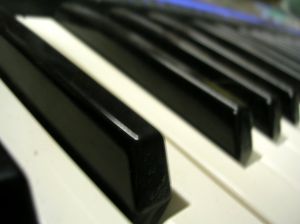
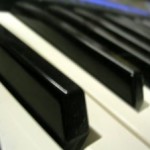 Your repertoire of jazz piano chords will undoubtedly include the exploration of quartal voicings if you are sincere in your interest in this art form. There is much to share when it comes to quartal voicings and we do acknowledge them in
Your repertoire of jazz piano chords will undoubtedly include the exploration of quartal voicings if you are sincere in your interest in this art form. There is much to share when it comes to quartal voicings and we do acknowledge them in 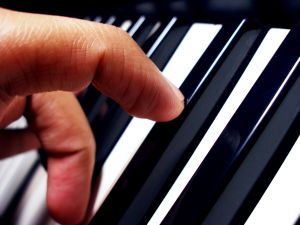
 Our focus on cocktail piano chords has included some attention on open chord voicings. As a review, let’s consider one way we can open up a chord like a Major 7th. We’ll use Fmaj7 for our example. This chord, in its most basic form (root position) is spelled like this:
Our focus on cocktail piano chords has included some attention on open chord voicings. As a review, let’s consider one way we can open up a chord like a Major 7th. We’ll use Fmaj7 for our example. This chord, in its most basic form (root position) is spelled like this: Play this new chord voicing as we have illustrated it and listen. Then compare the one preceding it by playing them both back and forth. It’s interesting how making one simple modification can change the texture of the voicing we are playing.
Play this new chord voicing as we have illustrated it and listen. Then compare the one preceding it by playing them both back and forth. It’s interesting how making one simple modification can change the texture of the voicing we are playing.
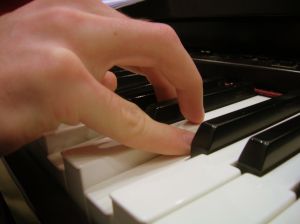
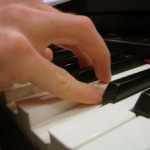 Our journey with jazz piano chords continues as we take a look at upper structure triads. There are several of these and, here, will take a look at one.
Our journey with jazz piano chords continues as we take a look at upper structure triads. There are several of these and, here, will take a look at one. The drop 3 voicing is one of those piano chords that can be endlessly explored… and well worth the time and effort, too! Adding this concept to your cocktail piano playing will most surely add more interest to those standard songs.
The drop 3 voicing is one of those piano chords that can be endlessly explored… and well worth the time and effort, too! Adding this concept to your cocktail piano playing will most surely add more interest to those standard songs. Okay, let’s turn this into a drop 3. Again, we will take that 3rd note from the top (in this case, the Bb) and move it one octave below:
Okay, let’s turn this into a drop 3. Again, we will take that 3rd note from the top (in this case, the Bb) and move it one octave below: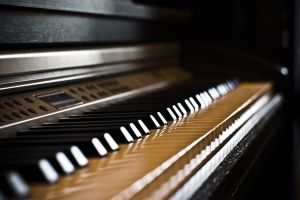 During our last lesson that focused on jazz piano chords, we took a look at a very popular way to voice that II-V chord progression among the pros. It’s interesting to note that this II-V chord progression is the most common chord progression in all of jazz and pop harmony. Well, let’s take a look at an extension of this progression…
During our last lesson that focused on jazz piano chords, we took a look at a very popular way to voice that II-V chord progression among the pros. It’s interesting to note that this II-V chord progression is the most common chord progression in all of jazz and pop harmony. Well, let’s take a look at an extension of this progression…

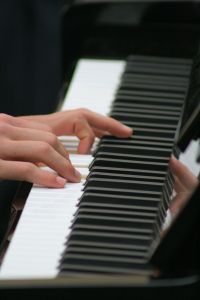 As our fun with jazz piano chords continues, here we will make reference to a previous lesson that focused on turning a minor 7th chord into a minor 9th chord. Specifically, we will use the same Dmin9 chord voicing for our purpose.
As our fun with jazz piano chords continues, here we will make reference to a previous lesson that focused on turning a minor 7th chord into a minor 9th chord. Specifically, we will use the same Dmin9 chord voicing for our purpose.  These are two of the most popularly played jazz piano chords of all time. Again, it’s that one little “switch” that turns the Dmin9 into a G13 chord.
These are two of the most popularly played jazz piano chords of all time. Again, it’s that one little “switch” that turns the Dmin9 into a G13 chord.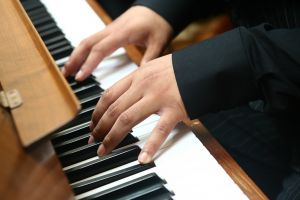 Let’s take a look at a couple of jazz piano chords that, when played one after the other, make for one of the most popular endings of all time. We will relate this to the key of C Major for our illustration. Of course, as always, you are highly encouraged to transpose what you learn to other keys.
Let’s take a look at a couple of jazz piano chords that, when played one after the other, make for one of the most popular endings of all time. We will relate this to the key of C Major for our illustration. Of course, as always, you are highly encouraged to transpose what you learn to other keys.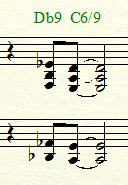
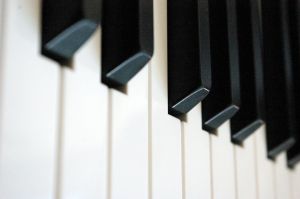 Any discussion of jazz piano chords much acknowledge this popular chord voicing among the pros. It’s a stock voicing that you’ve got to know. It’s another one of what we call rootless voicings. Many times when a min7 chord is called for, this is one that is used…
Any discussion of jazz piano chords much acknowledge this popular chord voicing among the pros. It’s a stock voicing that you’ve got to know. It’s another one of what we call rootless voicings. Many times when a min7 chord is called for, this is one that is used…